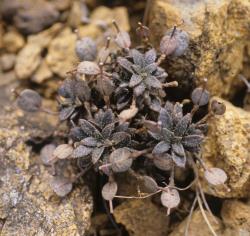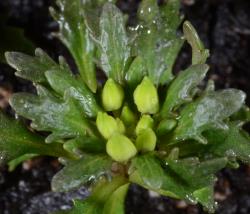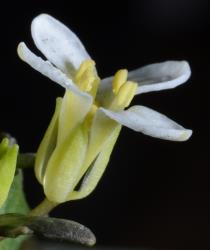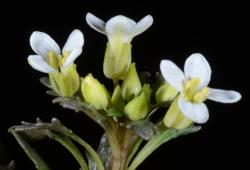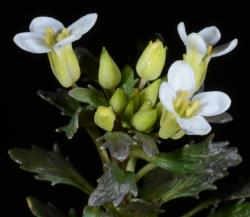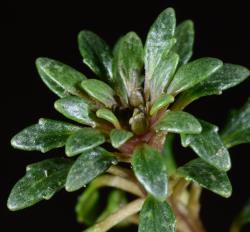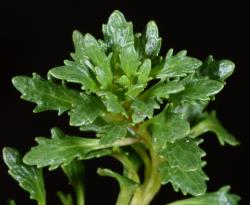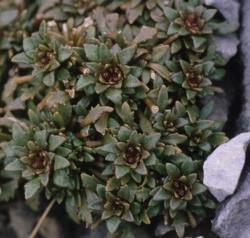- Taxon
- Gallery
- = Thlaspi australe Hook.f., Bot. Antarct. Voy. II (Fl. Nov.-Zel.) Part II, 39 (1855)
- = Notothlaspi australe var. stellatum Kirk, Stud. Fl. New Zealand 39 (1899)
Perennial herb, usually with short lateral branches or elongated stems, stems 1.0–2.2 mm diam., forming single rosettes or open, loose cushions of few to numerous rosettes. Leaves 5.5–21.0(–35.0) mm long, rosulate or spreading on stems; lamina 3.5–10.5 mm long, 3.0–6.5 mm wide, ovate to broadly ovate, green, brown or green-brown, coriaceous, adaxial surface usually glabrous or occasionally sparsely hairy, abaxial surface glabrous; margin usually toothed, with 1–6 pairs of teeth, teeth 0.3–1.2 mm long, forward projecting; apex obtuse to subacute, base cuneate to obtuse; petiole 2.0–9.0(–24.0) mm long, usually distinct from lamina. Inflorescence usually axillary, flowers solitary, sometimes terminal and flowers cymose; peduncle 8–22 mm long, 0.5–0.7 mm diam., ascending, usually glabrous, occasionally sparsely hairy. Sepals 2.9–5.6 mm long, 1.2–2.5 mm wide, linear-lanceolate, green, usually glabrous, occasionally sparsely hairy, margin entire, apex subacute, base truncate. Petals 6.2–10.2 mm long, 2.5–4.8 mm wide, white, limb broadly obovate to broadly elliptic, patent to reflexed; apex obtuse; base cuneate, tapering to a 3.0–4.0 mm long claw. Stamens 6; filaments, linear, two 2.8–4.4 mm long, four 3.8–5.3 mm long; anthers 1.0–1.4 mm long, cream to pale yellow. Ovary 2.2–3.5 mm long, 0.9–1.3 mm wide, compressed, green, brown or green-brown, glabrous; ovules 5–10 per locule; style 1.2–3.0 mm long; stigma capitate, 0.4–0.5 mm diam. Silicle 6.0–9.8 mm long, 6.0–8.1 mm wide, glabrous, green, brown or green-brown, obcordate, orbicular, orbicular-obovate, angustiseptate; valves keeled, winged, wing c. 0.4 wide at base, 1.8–2.5 mm wide at apex; style persistent 0.8–2.5 mm long. Seeds 1.1–1.2 mm long, 0.8–0.9 mm wide, orbicular-oblong, brown. Chromosome number 2n = 90–100 (CHR 518401; CHR 518402).
© Magnolia Press. Reproduced from Heenan 2019 (Phytotaxa 399 (3): page 251) with permission from Magnolia Press.
It occurs on rock outcrops, bluffs, and shingly sites from c. 700 to 1800 m, where it often grows on shaded sites such as ledges and crevices. It occurs on a wide range of soil types, including those derived from greywacke, limestone, marble and ultramafic parent materials (Heenan 2019).
Notothlaspi australe is assessed as having a conservation status of Not Threatened (de Lange et al. 2018).
FL Nov–Mar; FT Jan–Apr (Heenan 2019).



